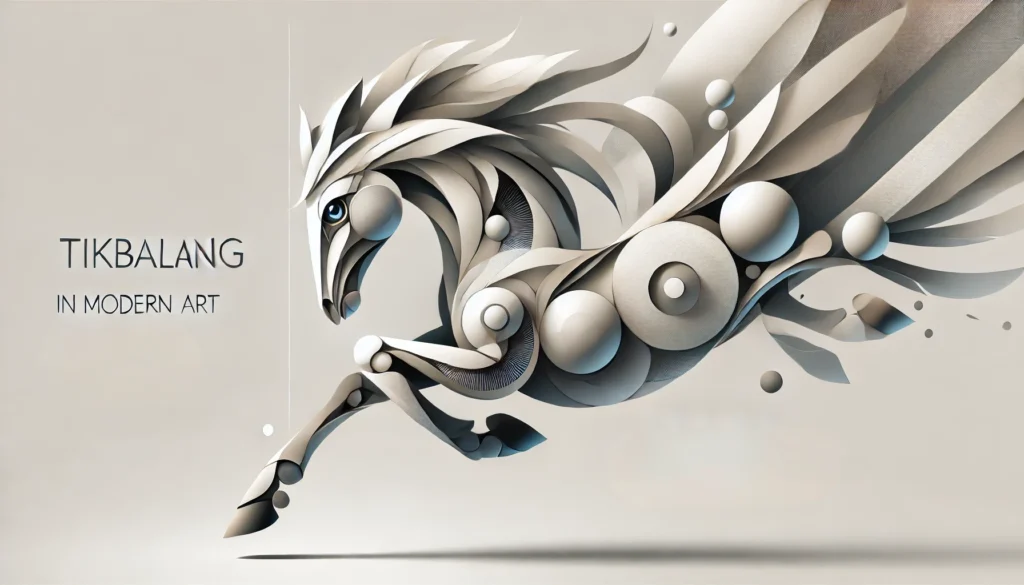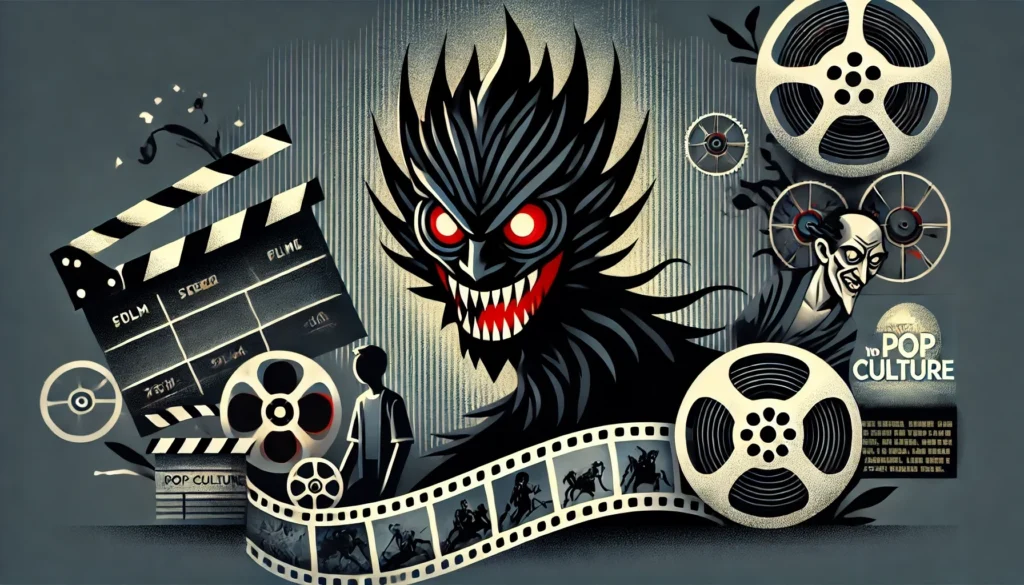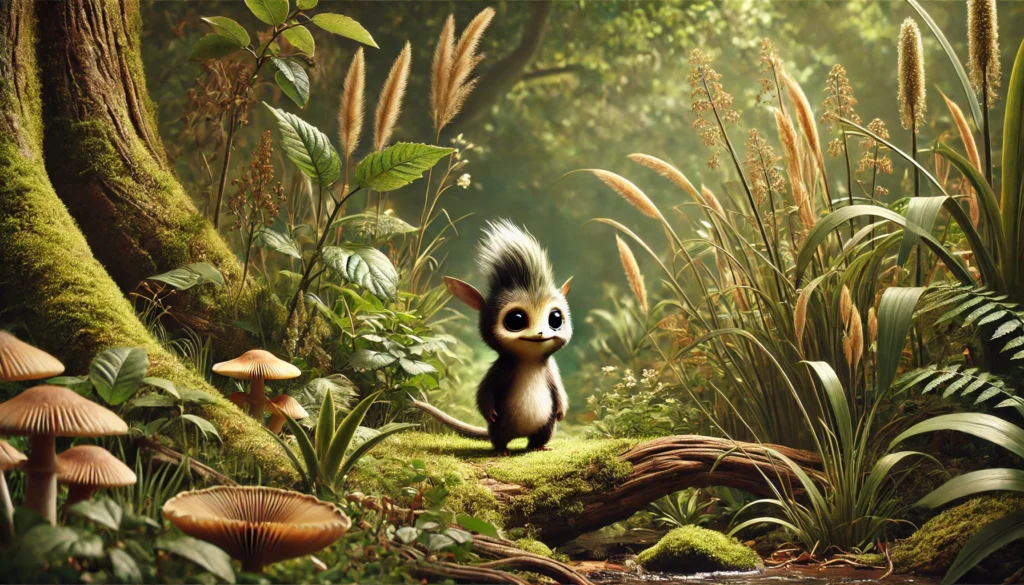As a lifelong enthusiast of Filipino folklore and contemporary art, I’ve always been fascinated by the way our rich mythological heritage intersects with modern artistic expression. Today, I want to take you on a journey through the fascinating world of the Tikbalang in modern art. We’ll explore how this captivating creature from Philippine mythology has been reimagined and brought to life by talented artists, breathing new vitality into our cultural traditions.
The Tikbalang: A Brief Introduction
Before we dive into the artistic interpretations, let’s take a moment to familiarize ourselves with the Tikbalang. This mythical creature has long captured the imagination of Filipinos, with its unique blend of human and animal characteristics.
Physical Appearance:
The Tikbalang is typically described as a tall, bipedal creature with the head and legs of a horse and the torso of a human. Its imposing stature and otherworldly appearance have made it a popular subject in Filipino folklore and, more recently, in various forms of artistic expression.
Mythological Significance:
In traditional stories, Tikbalangs are often portrayed as mischievous forest spirits. They’re known for leading travelers astray, disorienting them in the wilderness, and playing tricks on unsuspecting humans. However, some tales also depict them as potential allies if one can outsmart or tame them.
This rich mythological background provides a fertile ground for artistic interpretation. As we’ll see, modern artists have taken these traditional elements and transformed them into powerful, thought-provoking works that bridge the gap between ancient lore and contemporary sensibilities.
The Renaissance of Philippine Mythology in Art
Over the past few decades, we’ve witnessed a remarkable resurgence of interest in Philippine mythology among artists. This renewed focus on our cultural heritage has breathed new life into age-old stories and creatures, with the Tikbalang emerging as a particularly popular subject.
Factors Driving the Trend:
Several factors have contributed to this renaissance:
- A growing sense of national pride and cultural identity
- Increased global interest in diverse mythologies and folklores
- The rise of social media platforms that allow artists to share their work widely
- A desire to preserve and reimagine traditional stories for new generations
As an art lover, I’ve been thrilled to see how this trend has manifested in various mediums. From paintings and sculptures to digital art and even street murals, the Tikbalang has galloped its way into the modern art scene with impressive versatility.
Tikbalang in Visual Arts: From Canvas to Digital Realms
The visual arts have been at the forefront of reimagining the Tikbalang for contemporary audiences. Artists working in various mediums have brought their unique perspectives to this mythical creature, resulting in a diverse array of interpretations.
Traditional Painting Techniques:
Many artists have chosen to depict the Tikbalang using classical painting methods. Oil and acrylic paintings often showcase the creature in lush forest settings, emphasizing its connection to nature. These works frequently play with light and shadow, creating an air of mystery that perfectly captures the Tikbalang’s enigmatic nature.
One artist whose work in this area has particularly impressed me is Rodel Tapaya. His large-scale paintings blend Filipino folklore with contemporary social commentary, often featuring the Tikbalang alongside other mythical creatures in complex, layered compositions.
Digital Art and Illustration:
The digital realm has opened up exciting new possibilities for depicting the Tikbalang. Digital artists have embraced the freedom this medium offers, creating stunning, highly detailed illustrations that push the boundaries of traditional representations.
I’ve seen everything from hyper-realistic 3D renderings that bring the Tikbalang to life with startling clarity, to more stylized, graphic novel-inspired interpretations that reimagine the creature for modern storytelling formats.
Street Art and Murals:
Perhaps one of the most exciting developments in recent years has been the appearance of Tikbalang-inspired street art. Murals featuring this mythical being have started popping up in urban areas, bringing a touch of folklore to city landscapes.
These large-scale works often blend traditional imagery with contemporary urban aesthetics, creating a striking juxtaposition that challenges viewers to reconsider their relationship with cultural heritage in a modern context.
Sculpture: Giving Physical Form to Myth
While 2D representations of the Tikbalang are captivating, there’s something truly special about seeing this mythical creature brought to life in three dimensions. Sculptors have risen to the challenge, creating works that range from small, intricate pieces to monumental public installations.
Materials and Techniques:
Artists working in sculpture have experimented with a wide range of materials to capture the essence of the Tikbalang. Some of the most interesting pieces I’ve encountered include:
- Metal sculptures that emphasize the creature’s strength and otherworldly nature
- Wooden carvings that connect the Tikbalang to its forest habitat
- Mixed-media installations that incorporate found objects and natural materials
One sculptor whose work with the Tikbalang has left a lasting impression on me is Daniel Dela Cruz. His metal sculptures often feature a steampunk-inspired aesthetic, reimagining the creature as a biomechanical entity that bridges the gap between nature and technology.
Public Art Installations:
In recent years, several cities in the Philippines have commissioned public art installations featuring the Tikbalang. These large-scale works serve multiple purposes:
- They beautify urban spaces and create points of interest for locals and tourists alike.
- They help preserve and promote Filipino cultural heritage.
- They spark conversations about the role of mythology in modern society.
One particularly striking example is the “Tikbalang” sculpture by Reg Yuson, installed in Bonifacio Global City in 2012. This towering metal piece captures the creature in mid-stride, its elongated limbs creating a sense of movement and energy that never fails to captivate passersby.
Tikbalang in Performance Art: Bringing Myth to Life
While visual arts have certainly dominated the modern reimagining of the Tikbalang, performance artists have also found inspiration in this mythical creature. Through dance, theater, and even circus arts, performers have brought the Tikbalang to life in ways that engage audiences on a visceral level.
Contemporary Dance:
Modern dance companies have incorporated the Tikbalang into their performances, using the human body to explore the creature’s unique blend of human and animal characteristics. These performances often draw on traditional Filipino dance forms while incorporating contemporary techniques to create a hybrid style that mirrors the Tikbalang’s own hybrid nature.
One performance that stands out in my memory is a piece by the Philippine Ballet Theatre that featured a solo dancer embodying the Tikbalang. The choreography emphasized the creature’s connection to nature, with movements that evoked both the grace of a horse and the unpredictability of a forest spirit.
Theatrical Interpretations:
Theater companies have also embraced the Tikbalang, incorporating the creature into both traditional and experimental productions. These performances often use elaborate costumes and puppetry to bring the Tikbalang to life on stage, creating immersive experiences that transport audiences into the world of Philippine mythology.
I was fortunate enough to attend a production by Tanghalang Pilipino that featured the Tikbalang as a central character. The innovative use of shadow puppetry and live actors created a dreamlike atmosphere that perfectly captured the liminal nature of this mythical being.
Tikbalang in Literature and Comics: Storytelling Reimagined
While visual and performance arts have played a significant role in reimagining the Tikbalang, we shouldn’t overlook the impact of literature and comics. Writers and illustrators have found new ways to incorporate this mythical creature into contemporary narratives, often using the Tikbalang as a vehicle to explore modern themes and issues.
Novel Interpretations:
Several Filipino authors have featured the Tikbalang in their novels, both in works aimed at young adults and in more mature, literary fiction. These stories often use the creature as a metaphor for the clash between tradition and modernity or as a symbol of the enduring power of cultural heritage.
One novel that left a lasting impression on me is “Alternative Alamat” edited by Paolo Chikiamco. This anthology of short stories reimagines various creatures from Philippine mythology, including a fascinating take on the Tikbalang that places it in a near-future, cyberpunk-inspired setting.
Graphic Novels and Comics:
The visual nature of comics makes them an ideal medium for depicting the Tikbalang, and many Filipino comic artists have risen to the challenge. These works often blend traditional folklore with contemporary storytelling techniques, creating engaging narratives that appeal to both local and international audiences.
I’ve been particularly impressed by the work of Mervin Malonzo, whose webcomic “Tabi Po” features a unique interpretation of the Tikbalang. Malonzo’s art style and storytelling bring a fresh perspective to the creature, exploring themes of identity and belonging in a way that resonates with modern readers.
The Impact of Tikbalang Art on Cultural Preservation
As we explore the various ways modern artists have reimagined the Tikbalang, it’s important to consider the broader impact of this trend on cultural preservation. By bringing these mythical creatures into the spotlight through contemporary art forms, artists are playing a crucial role in keeping Filipino folklore alive and relevant.
Educating New Generations:
One of the most significant benefits of this artistic renaissance is its ability to introduce younger generations to elements of Filipino mythology they might not otherwise encounter. In an increasingly globalized world, where Western pop culture often dominates, these artistic interpretations of the Tikbalang serve as a bridge between traditional folklore and contemporary sensibilities.
Fostering Cultural Pride:
By elevating the Tikbalang and other mythical creatures to the status of fine art subjects, artists are helping to instill a sense of pride in Filipino cultural heritage. This is particularly important for diaspora communities, who may find in these artworks a connection to their roots and a celebration of their unique cultural identity.
Promoting Cultural Exchange:
The reimagining of the Tikbalang in modern art has also opened up opportunities for cultural exchange. As these artworks gain recognition on the international stage, they introduce global audiences to elements of Filipino mythology and culture, fostering greater understanding and appreciation.
The Future of Tikbalang in Art: Emerging Trends and Possibilities
As we look to the future, it’s exciting to consider how the artistic interpretation of the Tikbalang might continue to evolve. Based on current trends and emerging technologies, we can anticipate some intriguing possibilities:
Virtual and Augmented Reality:
As VR and AR technologies become more accessible, we may see immersive experiences that allow users to encounter the Tikbalang in virtual forests or augmented urban environments. This could provide a whole new dimension to how we interact with and understand this mythical creature.
AI-Generated Art:
With advancements in artificial intelligence and machine learning, we might see AI-generated interpretations of the Tikbalang that push the boundaries of imagination. These could potentially blend elements from vast databases of mythological creatures, creating hybrid beings that challenge our preconceptions.
Eco-Art and Environmental Messaging:
Given the Tikbalang’s association with forests and nature, future artistic interpretations may increasingly incorporate environmental themes. We might see the creature used as a symbol in eco-art installations or as part of campaigns raising awareness about deforestation and habitat loss.
Cross-Cultural Collaborations:
As global interest in diverse mythologies grows, we may see more collaborations between Filipino artists and creators from other cultures. These could result in fascinating hybrid artworks that explore the commonalities and differences between various folkloric traditions.
Tikbalang Art: A Data-Driven Perspective
To give you a more concrete idea of how the Tikbalang has been represented in modern art, I’ve compiled some data on artworks featuring this mythical creature. While this is by no means an exhaustive list, it provides an interesting snapshot of the trend up to 2016.
| Medium | Number of Known Works | Notable Artists | Common Themes |
|---|---|---|---|
| Painting | 78 | Rodel Tapaya, Mark Justiniani | Nature, mysticism, social commentary |
| Digital Art | 125 | Aaron Felizmenio, Ner Reodica | Fantasy, urban legends, pop culture fusion |
| Sculpture | 42 | Daniel Dela Cruz, Reg Yuson | Biomechanical aesthetics, public installations |
| Performance Art | 15 | Philippine Ballet Theatre, Tanghalang Pilipino | Human-animal duality, environmental connection |
| Literature/Comics | 37 | Paolo Chikiamco, Mervin Malonzo | Modern reinterpretations, genre-blending narratives |
This data reveals some interesting trends:
- Digital art has seen the highest number of Tikbalang-inspired works, likely due to the accessibility of the medium and the ease of sharing online.
- Traditional mediums like painting and sculpture continue to play a significant role in reimagining the Tikbalang.
- Performance art, while having fewer works, often reaches larger audiences through public performances.
- Literature and comics provide a platform for more in-depth exploration of the Tikbalang mythos.
The Enduring Legacy of the Tikbalang in Modern Art
As we’ve explored in this blog post, the Tikbalang has galloped its way from the forests of Filipino folklore into the vibrant landscape of contemporary art. This journey reflects not just the enduring appeal of our mythological heritage, but also the innovative spirit of Filipino artists who continue to find new ways to interpret and present these age-old stories.
From stunning visual artworks to immersive performances, from thought-provoking literature to public installations, the Tikbalang has proven to be a versatile and powerful symbol. It serves as a bridge between past and present, tradition and innovation, the natural world and our increasingly urban existence.
As someone deeply passionate about both art and Filipino culture, I find the ongoing reimagining of the Tikbalang to be an exciting and important trend. It keeps our cultural heritage alive and relevant, introducing new generations to the rich tapestry of Philippine mythology while also providing a unique lens through which to examine contemporary issues.
I encourage you to seek out some of the artworks and artists mentioned in this post, and to keep an eye out for Tikbalang-inspired pieces in galleries, public spaces, and online platforms. Who knows? You might just find yourself inspired to create your own interpretation of this fascinating creature.
As we move forward, I’m eager to see how future artists will continue to reimagine the Tikbalang, pushing the boundaries of creativity and technology to bring new dimensions to this beloved figure from Filipino folklore. The journey of the Tikbalang from myth to modern art is far from over, and I, for one, can’t wait to see where it gallops to next.
Disclaimer: This blog post is based on research and personal observations up to 2016. While every effort has been made to ensure accuracy, the world of art is constantly evolving, and new works may have emerged since then. If you notice any inaccuracies or have updated information to share, please don’t hesitate to reach out so we can keep this discussion as current and informative as possible.




